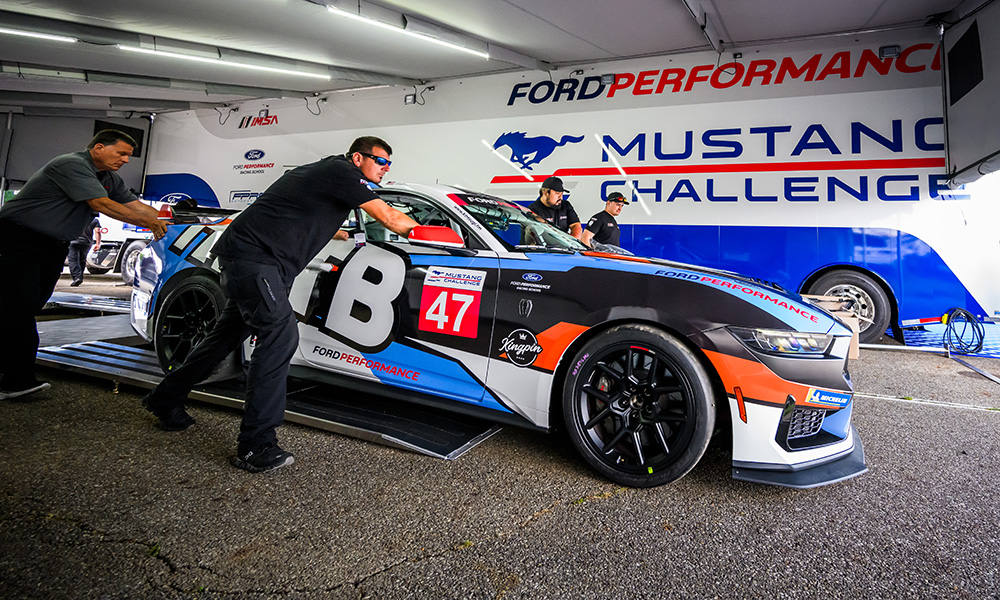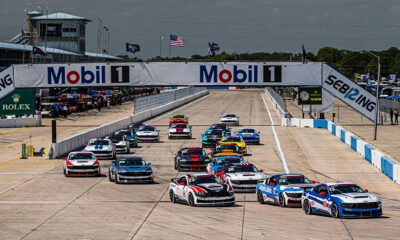
Photo: Ford Performance
Ford Performance is set to introduce multiple mechanical upgrades to its Mustang Dark Horse R in 2025, focusing on improving the production-based race car’s performance, reliability and serviceability on race weekends.
The changes, including new wheels and tires, new clutch and flywheel, and new suspension components, will be fitted to cars competing in the IMSA-sanctioned Mustang Challenge, including at the Le Mans Invitational round, and the upcoming USAC-sanctioned Mustang Cup championship.
“We had a great year,” said Ford Performance motorsports program supervisor Dave Born, “Especially when you are able to get a full field of cars on track, you notice potential avenues for development that you may not find in single-car testing.
“We’ve observed ways that we can continue to improve the competition level, and we have taken team feedback into account along the way so we can take purposeful action.”
To improve performance, the cars will now be fitted with 18-inch VS-5RE forged wheels from Apex Wheels, replacing the outgoing 19-inch setup. The new wheel and tire combination is set to be faster, lighter, and more drivable.
“It’s important that we promote tighter competition and an overall increase in performance across the board,” said Born. “We have gone from a flow-formed wheel to forged, which will save a significant amount of weight, and we have also decided on a more traditional construction on the tire.
“There has been better grip and lap times with these implemented changes.”
Born reported that recent testing at Virginia International Raceway showed the new wheels and tire combination to be “more forgiving” and better equipped to “recover quickly from being pushed beyond its capacity, while still delivering faster lap times.
“I think our top drivers can handle whatever we throw at them, but for the drivers that are a little bit further down the pack, this is going to make the car much more drivable for them,” he added.
Next year’s Dark Horse R race cars will also feature an improved clutch and flywheel system developed with Centerforce, allowing for faster engagement and disengagement of the clutch compared to the production clutch and dual-mass flywheel originally on the race car.
“Many of these drivers are shifting so hard and fast that their actions are quicker than that system can engage and disengage, and the transmission becomes a victim of that,” said Born “The engagement and disengagement are much crisper from what we’ve seen during test sessions, and it’s allowing the transmission to do the job that it’s intended to do.”
“[The new parts] should allow these drivers to go a lot more time or miles on their transmissions. An additional advantage is that it will also save weight, as the updated system is about six pounds lighter. The drivers have commented that they can feel the engine spinning up more quickly, so there might even be a side benefit of some performance there as well.”
Ford Performance has also utilized the adjustable rear camber arms from its Mustang GT4 car to improve the Dark Horse R rear camber adjustability.
“We have a really great system in the front, where teams can easily and efficiently swap shims around,” said Born. “They will know with each shim how many degrees of camber adjustment they are making.
“The production rear camber arms have proven difficult to make quick adjustments needed for racers. So, we turned to the adjustable camber arm from Mustang GT4, which is similar to the front in that it uses shims.
“We are bringing those parts down from the GT4 car, putting them into the Mustang Dark Horse R and it’s going to make that serviceability of the vehicle that much easier.
“There are certainly some more things in the works, but those are three big ones that the customers had commented on, and we listened, and we’re excited to get those revised parts out to them.”
Le Mans Invitational Round Prompts Final Drive Ratio Change
Mustang Dark Horse R will compete in a non-points-paying optional invitational round at Circuit de la Sarthe in June in support of the 24 Hours of Le Mans.
As a result, the cars will feature a new ring and pinion in the rear differential to account for both the straightaways at the French circuit and also some of the longer straights on U.S. tracks.
“It was really driven around looking forward to Le Mans,” said Born. “But as we look back at the tracks that we ran and the racing that we had this year, I think it’s going to be an improvement, really, everywhere here [in the U.S.] as well.”
A new 3.55-to-one ratio rear differential will replace the production 3.73-to-one, improving the Dark Horse R’s overall top speed.
“With the 3.73s the cars would top out fifth gear around the mid, low 150 [miles per hour range],” said Born. “Drivers were finding it easier to stay on the limiter this past season, as opposed to shifting into sixth and then back down.
“The 3.55, final drive ratio intended for Le Mans will allow competitors to be up into the upper 160s before they would need to shift out of fifth gear.
“It was Le Mans that drove the decision, but I think it’s going to roll back down into the U.S. tracks and be helpful for us here as well.”
Born mentioned that continually building upon the two Dark Horse R based series punctuates the commitment of Ford Performance to not only the sport, but also its future.
“Our Dark Horse R racing programs are not a marketing program for us,” said Born. “These changes funnel into a long-term plan and foundation of our entire sports car racing pyramid, and we are committed to its long-term success.”


























